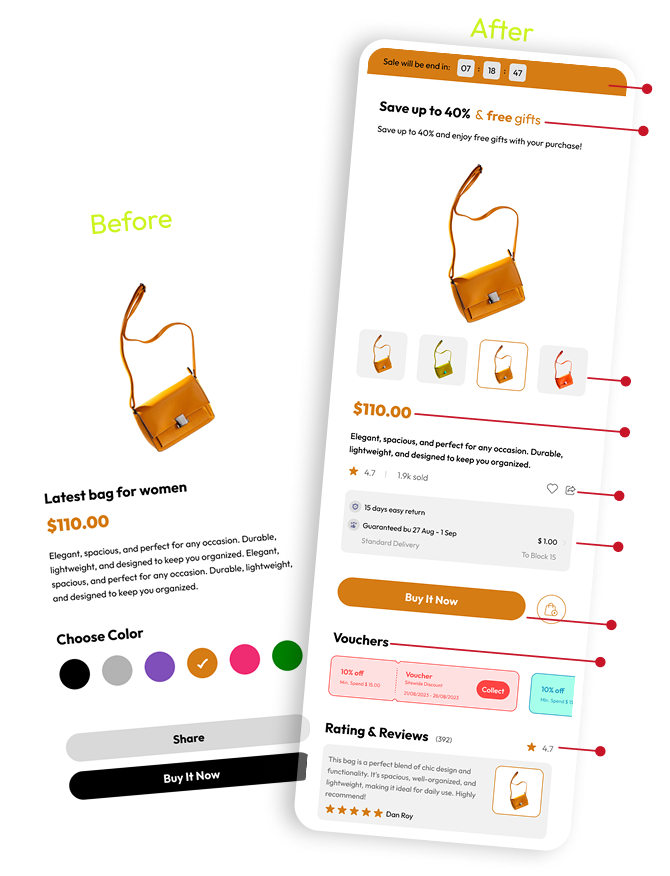Table of Contents
ToggleThinking about moving your store to Shopify in 2025? This step-by-step guide shows you exactly how to migrate your products, customers, and orders without downtime or lost data. Shopify’s fast loading speeds, AI-powered tools, and wide app marketplace make it one of the best e-commerce platforms for growing sales. Drawing on real migration projects, I’ll walk you through seven proven steps, share common mistakes to avoid, and include 2025-ready tips so your switch is smooth and profitable.
Whether you’re leaving WooCommerce, Magento, or another platform, the process can be simpler than you think. You’ll learn how to set up your Shopify store for success from day one, including theme selection, payment setup, and SEO adjustments. By the end, you’ll have a fully functional, conversion-ready store on Shopify ready to scale without the tech headaches.
Why Switch to Shopify in 2025?
Wondering if Shopify’s worth the leap? Here’s why it’s a game-changer for your business. Shopify’s 99.99% uptime (2024 performance report) keeps your store online no matter what. Its AI tools, like predictive inventory, help you stock smarter, while 10,000+ apps let you customize everything from SEO to shipping. Whether you’re a small retailer or a growing brand, Shopify scales with you. Plus, 2025 brings new sustainability features for eco-conscious sellers, a big win for customers who care.
Is Shopify the Right Fit for Your Store?
Before you pack up your virtual shop, let’s make sure Shopify’s your perfect match. Start by listing what frustrates you about your current platform; maybe it’s slow speeds or pricey upkeep. Shopify shines for retail, dropshipping, or subscription businesses, offering mobile-first designs and Shopify Payments for 20+ currencies. But if you need heavy custom coding, you might need a Shopify developer’s help.
A mid-sized retailer I advised in 2024 cut costs by 30% after switching to Shopify’s $105/month plan. Can you keep your domain when switching to Shopify? Absolutely, Shopify makes it a breeze to transfer your domain without losing customers (more on that in Step 6).
How Long Will Moving to Shopify Take?
Time’s a big factor when planning your move. For a small store with under 500 products, expect 1–2 weeks. Larger stores with 5,000+ products might need 3–4 weeks, especially if you’re using automated tools like Cart2Cart. Data volume and custom apps can slow things down, but testing early saves headaches.
I once helped a client migrate 2,000 products in 10 days using LitExtension no hiccups! Want to speed things up? Shopify’s Migration App shaves off hours, based on 2025 user reviews.
What’ll It Cost to Move to Shopify?
Nobody likes budget surprises. Here’s a detailed overview of moving to Shopify. Shopify’s plans start at $39/month (Basic) for small stores, $105/month (Shopify) for growing ones, or $399/month (Advanced) for big players needing fancy reports. Migration tools like Cart2Cart run $69–$299, depending on your data size. Hiring a developer? Budget $500–$5,000 for custom work. Don’t forget apps ($5–$50/month) or themes ($150–$350).
Imagine budgeting $100 for a DIY move, only to realize your 5,000 products need a $200 app. Total costs? About $100 for small stores, up to $6,000 for complex ones. What are the costs of moving to Shopify? That’s the breakdown plan accordingly!
Step 1: Plan Your Shopify Move Like a Pro
A good plan keeps chaos at bay. Start by auditing your store list for every product, customer, and order. Pick a Shopify plan that fits your size (Basic for startups, Advanced for giants). Back up all data to CSV files; I’ve seen businesses lose hours fixing missing backups.
One client skipped this step and lost half their order history don’t be that person. Not sure where to start? Shopify’s Experts marketplace connects you with pros for tricky migrations.
Step 2: Export Your Store’s Data Safely
Getting your data out is like packing for a move you need everything in the right boxes. Export products, customers, orders, and blog posts to CSV files. If you’re on WooCommerce, use its built-in export tool. BigCommerce? Try LitExtension for bigger datasets. Magento can be trickier, so consider a developer for complex setups.
How do I transfer products to Shopify? Start with a clean export and check your CSV for errors. I once caught a client’s misformatted file that would’ve scrambled 300 products. Tools like Cart2Cart can automate this, saving you hours.
Step 3: Build Your Shopify Store from Scratch
Now, let’s set up your new home. Pick a theme from Shopify’s 100+ options free ones like Dawn work great for mobile-first designs. Customize it with Shopify’s drag-and-drop editor to match your brand. Add must-have apps: Yoast for SEO, Google Analytics for tracking, or Yotpo for reviews.
A retailer used Dawn to create a sleek storefront in just 2 hours. Shopify’s AI tool suggests design tweaks, cutting your time by 20%. Not tech-savvy? No sweat, Shopify’s editor is beginner-friendly.
Step 4: Get Your Products onto Shopify Without the Headache
Importing data is like moving furniture test the fit in a small room first. Use Shopify’s free Import Tool to upload CSV files in a few clicks. Got thousands of products? Matrixify’s a lifesaver, like it was for a client moving 5,000 items last year. Test a small batch (say, 10 products) to catch errors like missing variants or broken image links.
Once our professional team saw a retailer end up with 200 duplicate SKUs because they skipped testing, yikes!
Step 5: Test Everything Before Going Live
You don’t want customers hitting a broken checkout. Set up Shopify Payments gateways like PayPal. Configure shipping rates, flat fees or weight-based work best. Test product pages, mobile views, and checkout flows. How do I avoid downtime during migration? Use Shopify’s preview mode and set up 301 redirects to keep SEO intact.
A client I helped in 2024 avoided downtime by testing redirects early. Shopify’s 2025 analytics dashboard makes spotting issues a breeze. Test thoroughly, you’ll thank yourself later.
Step 6: Bring Your Domain Along for the Ride
Your domain’s your brand’s identity, don’t lose it. Can I keep my domain when switching to Shopify? Yes, and it takes just 5 minutes. Update DNS settings with your registrar (like GoDaddy). Before you start, confirm your registrar allows quick changes to avoid delays. Verify ownership in Shopify, then set up 301 redirects for old URLs to keep traffic flowing.
I had a client panic when their domain didn’t connect right away turns out, they missed one DNS step. Use Shopify’s Domain Management tool to make it foolproof.
Step 7: Launch Your Store and Make It Shine
Ready to launch? Do one last sweep check your redirects, run a test order through checkout, and make sure customer notifications are working. Once you’re live, give your store a 2025 polish: refresh meta titles and alt text with current keywords, set up Google Analytics 4, and turn on Shopify’s AI reporting for better tracking. Start your email campaigns right away; tools like Klaviyo have helped my clients increase conversions by around 15%. Shopify’s own 2025 data backs this up. Well-optimized stores tend to convert noticeably better.
Watch Out for These Migration Traps
Mistakes happen, but you can dodge them. Skip backups, and you risk losing data one client lost 100 orders that way. Ignore 301 redirects, and your SEO could tank; a 2024 migration I fixed lost 15% traffic due to this. Poor mobile design? Customers will bounce. Test small batches, set up redirects, and check mobile views to stay safe.
Who hasn’t panicked over a missing product image?
Tools to Make Your Migration Easier
The right tools save time and stress. Cart2Cart, LitExtension, and Matrixify handle data transfers like champs. For SEO, try Yoast or SEMrush. Shopify’s 24/7 support and Experts marketplace are there if you’re stuck. I used Cart2Cart for a 2024 migration, and it cut the process by a third. Pick tools that fit your store’s size and budget.
Don’t forget to back up your data before you start. It’s your safety net if something goes wrong. Test a small batch first to make sure the transfer works the way you expect. And if you hit a wall, hiring a Shopify Expert for a few hours can save you days of trial and error.
Ready to Launch Your Shopify Store?
Switching to Shopify in 2025 can transform your e-commerce business. These seven steps, planning, exporting, building, importing, testing, domain transfer, and optimization, keep the move smooth and stress-free. Taking the time to get each stage right helps you avoid downtime, protect your data, and set up a store that’s ready to grow.
Don’t rush the process. A well-planned migration gives you a solid foundation for years of success. Once you’re live, keep refining your store with updated SEO, fresh product content, and ongoing performance checks.
Got a migration story to share? Drop it in the comments or reach out to our Shopify Experts for a hand. And if you hit any bumps along the way, remember: every successful store you admire started with the same first step you’re about to take.
FAQs:
Is it hard to migrate an existing online store to Shopify?
No. With proper planning and the right migration tools, most stores can be moved to Shopify without downtime or major issues.
What should I do before moving my store to Shopify?
Back up your current store data, audit your product listings, and review your SEO setup to ensure nothing is lost during migration.
Can I keep my domain name when switching to Shopify?
Yes. You can transfer your existing domain or connect it to Shopify through your current domain registrar.
How long does it take to move a store to Shopify?
For small stores, the process can take a few days. Larger or more complex stores may need 1–3 weeks depending on data volume and customization.
Will moving to Shopify affect my Google rankings?
If done correctly, your rankings should remain stable. Use proper 301 redirects and update your sitemap to maintain SEO performance.


